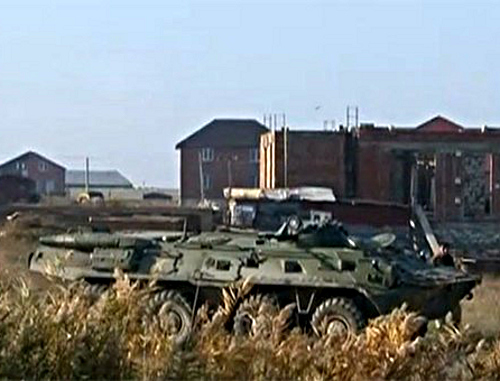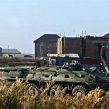
Ibragim Gajidadaev, Dagestan’s Most Wanted Militant, Involved in Makhachkala Shootout
Publication: Eurasia Daily Monitor Volume: 10 Issue: 54
By:

Media reports about a government special operation in the suburban town of Semender near Makhachkala, Dagestan, would not have captured anybody’s attention (www.moidagestan.ru/news/antiterror/26153) had there not been several strong reasons to pay attention to it. This special operation indicated how deep and complex the links between the militants and the authorities are in the republic. The police operation targeting rebels in Semender started at 6 a.m. on March 20. However, government forces did not actually seal off the whole town, but specifically targeted the house of the chairman of the Untsukul district council, Magomedkhabib Magomedaliev (www.kavkaz-uzel.ru/articles/221691/). The council chairman’s wife and two small children aged six and eight years old were also believed to be in the house. The official news agency of Dagestan, RIA-Dagestan did not comment on the events that unfolded in Semender for seven hours, preferring to cover rising flu rates in Russia and French athletes (www.riadagestan.ru/index.php).
The special operation was expected to neutralize one of the most notorious leaders of the Dagestani jamaat—Ibragim Gajidadaev, head of the Gimry militants, who took responsibility for the assassination of Dagestani Interior Minister Adilgirey Magomedtagirov at a wedding in Makhachkala in 2009. According to the investigators, Gajidadaev, among other militant leaders, was behind the double suicide attack in the Moscow metro in 2010 (https://moscow-info.org/articles/2010/04/06/165920.phtml). He reportedly was also the mastermind of the killing of Dagestani presidential spokesman Garun Kurbanov in July 2011 (www.webcitation.org/68VNKKxzq). The assassination of republican parliamentary deputy Gazimagomed Magomedov in 2007 was also attributed to Gajidadaev. Thus, this insurgent leader can easily be considered one of the most notorious figures of the Dagestani militancy. The 39-year-old Gajidadaev is a two-time European champion and a world champion in the Chinese martial arts Wushu Sanda (www.kavkaz-uzel.ru/articles/128729). He came under the influence of Salafist ideas, left his brilliant career and joined the insurgency. Russian media have mistakenly called Gajidadaev the emir of Dagestan’s Sharia Jamaat, but he never was the leader of the entire jamaat of Dagestan. In their attempts to catch him, the authorities would seal off the village of Gimry for months at a time. The village, one of the most famous places in Dagestan, was the birthplace of the 19th century Dagestani imams Gazi-Mulla and Shamil (https://regnum.su/news/1035416.html). Gajidadaev’s importance demonstrates that there could hardly have been more important news for RIA-Dagestan to cover on March 20, but the news agency chose to ignore it.
Media reports alleged that the house of district council chairman Magomedkhabib Magomedaliev was unblocked by the afternoon of March 20. However, this was not confirmed by reports from people on the ground (www.kavkaz-uzel.ru/articles/221702/), as the police were still searching for rebels throughout the household. Several circles consisting of hundreds of servicemen and including Armored Personnel Carriers (APCs) surrounded the site of the counterterrorist operation. Dagestani police officers were not allowed to participate in the operation. According to some reports, the police officers let district council member Magomedaliev, his spouse and children leave the house, after which Magomedaliev himself was forced to put on a helmet, take a video recorder, enter a nearby home and observe his own house to find out who was hiding in it. Over the course of the police operation, all the suspected rebels in the house and its basement were killed, possibly including Ibragim Gajidadaev (www.kavkaz-uzel.ru/articles/221732/).
The most interesting aspect of this event is the set of circumstances surrounding it. Why did the home of district council chairman Magomedaliev come under suspicion? The council chairman’s personality is intriguing: 34-year-old Magomedaliev was sentenced three times in courts, but still managed to become a council member after joining the United Russia party. He was considered locally to be a politician with fairly good prospects (https://ruuuulezzzz.livejournal.com/662.html). Magomedaliev chairs the district council in Untsukul district, where Ibragim Gajidadaev comes from. One is left with the impression that the authorities and members of the armed resistance became closely intertwined and this feature is simply a hallmark of Dagestan. Despite the months-long counter-terrorism operation regime in Gimry and the complaints of locals about its harshness, they did not turn in anyone from Ibragim Gajidadaev’s jamaat: indeed, they apparently hid the insurgents. It is not surprising that the police eventually began to suspect that the Gimry authorities were providing protection for the leader of the village’s jamaat.
In general, the Dagestani authorities in the mountainous areas either directly or indirectly have to make deals with the insurgents to ensure that the militants do not target them. Without a mutually acceptable agreement, the local authorities would hardly be able to function in remote areas of the republic. Speaking of the influence of informal leaders in Dagestan, there are Avar figures (www.moidagestan.ru/news/analytics/2307) whose impact on the situation in the republic can be quite substantial. The authorities and the rebels can arrive at mutually acceptable solutions if the authorities pay money to the rebels or shield them from the special operations (https://kavpolit.com/sprut-klana-shixmagomedova/).
Another interesting aspect is the fact that the special operation took place in a suburb of Makhachkala. As was mentioned earlier, the Dagestani militants, like their counterparts in Kabardino-Balkaria, Karachaevo-Cherkessia, Ingushetia and the Nogai areas, practically do not reside outside of the towns. Militants in these republics may have caches of ammunition and bases in the forested and mountainous areas, but they themselves reside inside the towns. Only the Chechen militants tend to reside outside the major urban areas. This is why counter-terrorist operations take place in Dagestani settlements, not in the republic’s mountains.
Thus, the latest counter-terrorist operation in Makhachkala’s suburb illuminates the range of possible problems that Dagestani society faces today. The killing of another notorious militant is more significant for the government forces than for the militants, who are prepared to die when they join the insurgency. The republican authorities demonstrate that they cannot resolve Dagestan’s issues. As long as the front lines of the special forces are occupied by the Russian security services rather than ethnic Dagestanis, the authorities are unlikely to tip the balance back in their favor.




